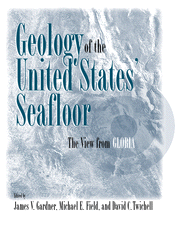Book contents
- Frontmatter
- Contents
- Contributors
- Foreword
- Introduction
- Part I The GLORIA System and Data Processing
- Part II U. S. East Coast EEZ
- Part III Gulf of Mexico and Caribbean EEZ
- Part IV U. S. West Coast EEZ
- Part V Alaskan EEZ
- Introduction
- 15 Sediment Pathways in Gulf of Alaska from Beach to Abyssal Plain
- 16 Sedimentation Along the Fore-Arc Region of the Aleutian Island Arc, Alaska
- 17 Aleutian Basin of the Bering Sea: Styles of Sedimentation and Canyon Development
- 18 Geology of the Kula Paleo-Plate, North Pacific Ocean
- Index
16 - Sedimentation Along the Fore-Arc Region of the Aleutian Island Arc, Alaska
Published online by Cambridge University Press: 25 January 2010
- Frontmatter
- Contents
- Contributors
- Foreword
- Introduction
- Part I The GLORIA System and Data Processing
- Part II U. S. East Coast EEZ
- Part III Gulf of Mexico and Caribbean EEZ
- Part IV U. S. West Coast EEZ
- Part V Alaskan EEZ
- Introduction
- 15 Sediment Pathways in Gulf of Alaska from Beach to Abyssal Plain
- 16 Sedimentation Along the Fore-Arc Region of the Aleutian Island Arc, Alaska
- 17 Aleutian Basin of the Bering Sea: Styles of Sedimentation and Canyon Development
- 18 Geology of the Kula Paleo-Plate, North Pacific Ocean
- Index
Summary
Abstract
A geophysical survey (including GLORIA) of the southern margin of the Aleutian Island Arc, north Pacific, from Umnak Island to Stalemate Ridge allowed fore-arc sedimentation patterns to be analyzed. Direct and indirect variables govern the availability, volume, and composition of sediment supplied to the fore-arc. Direct variables include the changing thermal aspect and convergence angle of the subducting plate and associated volcanism. Convergence along the Aleutian Arc ranges from orthogonal through oblique to parallel. Tectonics impact on both the magmatic arc and the fore-arc and include folding and block faulting in the forearc basin, plate decoupling, fragmentation and block rotation of the magmatic arc, and large-scale strike-slip with translation. Indirect variables include sea-level changes, global climate, ocean circulation, and biogenic productivity.
The high-latitude location of the arc has ensured that glacial pulses since the Pliocene exerted a marked influence on the patterns of sediment deposition along the slope and subsequent redeposition into the fore-arc basin. Four tectonically dominated depositional models are recognized. In an Unalaska Type A model orthogonal convergence and fore-arc compression result in slope aprons and fans feeding fore-arc depocenters by mass failure and debris flows, which translate downslope into channel-levee systems. In a Yunaska-Atka Type B model, convergence is slightly oblique, giving a mixed compressional and extensional tectonic pattern. Slope aprons are prominent sediment sources, but basin inversion with compensation cycles results in complex sequences. The emergence of discrete shear zones exceeding 20 km in width is a special feature.
- Type
- Chapter
- Information
- Geology of the United States' SeafloorThe View from GLORIA, pp. 279 - 304Publisher: Cambridge University PressPrint publication year: 1996



